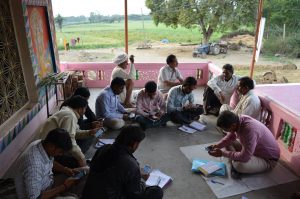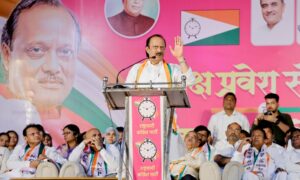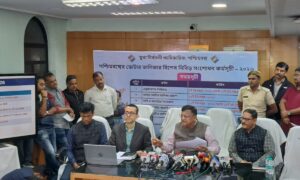
Image: Outline India
By Shekhar Chandra
‘Good Governance’ is considered panacea to achieve inclusive growth. However, measuring governance has been a huge challenge for social scientists. In spite of high per capita income, some States have failed to provide basic amenities of a respectable livelihood to their populace, which could be attributed to governance deficit. We use data from the health sector and primary education sector to understand the degree to which governance exists in these areas of the social sector. We look at the health and primary education sector because there is an increasing focus on Social Sector to achieve human development by promoting inclusive growth which is reflected in increasing budgetary outlays in Social Sector (e.g., 198,886 crore in Education, 100,753 crore in Health and 41,826 crore in Water & Sanitation, recommended in 11th Five Year Plan).
Methodology used to measure governance
To understand governance in health sector, we develop Health Services Index (HSI), which is the ratio of infant mortality index to the doctors availability index (refer, table-1). The idea behind looking at the mortality rate per available doctor was to come out with a uniform criterion of governance measurement for States because some might claim that States with lesser number of doctors could reduce infant mortality rates, if they too were provided with more number of doctors.
Punjab has the highest number of doctors (1.38) per 10,000 persons and Gujarat has the lowest number of doctors (.40) per 10,000 persons. Infant mortality rate is highest in case of Madhya Pradesh (72 per 1000 births) and lowest in case of Kerala (13 per 1000 births). Based on these values, Health Services Index (HSI) is highest for Maharashtra (1.287) and lowest for Rajasthan (.285).
TABLE-1: GOVERNANCE DEFICIT IN HEALTH SECTOR
Now, assuming Maharashtra uses its available health infrastructure optimally because of its highest HSI, resource utilization for States is estimated by dividing HSI for States to that of Maharashtra. Based on the assumption that Maharashtra uses its health infrastructure optimally because of highest HIS, governance deficit is then estimated by subtracting resource utilization of States to that of Maharashtra. Based on these calculations, Orissa has the highest governance deficit when compared with the State using its resources optimally (Maharashtra) in the Health Sector.
To understand governance in primary education sector, we develop educational services index, which is the ratio of level of learning index to teachers availability index (refer, table-2). Resource utilization by States in the primary education sector is the ratio of education services indices (ESIs) of States to the maximum value of ESI, which is West Bengal (2.092). Further assuming that West Bengal uses its educational infrastructure optimally because of its highest ESI, governance deficit is estimated to understand the relative performance of various States as compared to West Bengal in primary education sector.
TABLE-2: GOVERNANCE DEFICIT IN PRIMARY EDUCATION SECTOR
Karnataka has the highest number (3.03) of teachers per 100 children (I-VIII Std) and Uttar Pradesh and West Bengal have lowest number of teachers (1.19 each). Level of learning is highest (74.83%) in case of Kerala and lowest (37.08%) in case of Tamil Nadu. Educational Services Index (ESI) is estimated to be highest (2.092) in case of West Bengal and lowest in case of Tamil Nadu (.30).
Now, assuming that West Bengal uses its available educational infrastructure optimally because of its highest ESI, resource utilization for States is estimated by dividing ESI for States to that of West Bengal. To understand the relative performance of various States as compared to West Bengal, governance deficit is then estimated by subtracting resource utilization of States to that of West Bengal. Based on these calculations, Tamil Nadu has the highest (69.72%) governance deficit in this Sector.
To conclude, the following points have emerged from the above analysis-
- There is lack of infrastructure in all the States. For example, doctors per 10,000 persons vary from Punjab (1.38) to Gujarat (.40). Similarly, the number of teachers per 100 children vary from 3.03 in Karnataka to 1.19 in West Bengal and Uttar Pradesh.
- Whatever infrastructure is available at their disposal, some States are performing better than others. In health sector, resource utilisation is most in case of Maharashtra and least in case of Orissa. Thus governance deficit varies from 4.26% in case of Kerala to 85% in case of Orissa. Similarly, in primary education sector, resource utilisation is most in case of West Bengal and least in case of Tamil Nadu. Governance deficit varies from 13.17% in case of Punjab to 69.72% in case of Tamil Nadu.
- One of the striking findings coming out of this analysis is that the States which are generally considered worst on governance indicators (Uttar Pradesh and Bihar) are doing well against commonly-held perception.
Shekhar Chandra, is a Research Fellow at Outline India. Shekhar has been associated with the Twelfth Plan Working Groups on Energy, Transport and Infrastructure Sectors while working as a Consultant to Dr. B.K. Chaturvedi, Member ( Energy) at the Planning Commission of India.
The post is first appeared on the Outline India’s Blog Section. To read the original article, please click Here.




















